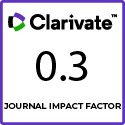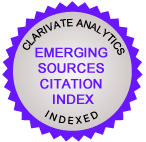Framing and natural disasters: framing the Chilean written press
-
Francisco Javier Tagle Montt
 fjtagle@uandes.cl
fjtagle@uandes.cl
Downloads
Abstract
Chile is a country that throughout its history has been constantly plagued by several natural disasters, which not only took the lives of thousands of citizens and caused pain and material losses, but also put to the test to both the authorities and the community. In this regard, the purpose of this research was to study how El Mercurio and La Tercera –the most important newspapers of the leading Chilean written press media‘s duopoly- framed the most destructive catastrophes that happened in the past two years: The Earthquake of Iquique and Coquimbo, The Alluvium of Copiapó and The Fire of Valparaíso.
All this in order to analyze both qualitatively and quantitatively the framing of these newspapers regarding the natural disasters, so the contributions and shortcomings of these Chilean press medias when reporting on these extreme situations can be established in a critical way, taking into account that normatively, to these phenomena, press is expected to be a forum both for balances of what happened, as for discussion on the future reconstruction.
Palabras Clave
Arias, M. y Pérez, M. (2014). Medios de comunicación utilizados post terremoto 27F en Chile según rango de edad y sexo, considerando vía de acceso, medios tradicionales, Redes Sociales y tiempo de contacto para comunicarse con amigos y familiares en escenario de catástrofe. Divergente: Santiago de Chile.
Asociación Chilena de Agencias de Publicidad (2013). Valida 2013 Segundo Semestre. Santiago de Chile: Asociación Chilena de Agencias de Publicidad.
Batllori Sampedro, E. A., Castillo Tzab, D., y Martínez López, J., E. (2008). Los medios de comunicación masiva ante los fenómenos naturales. Espacios Públicos, 11.
Cisternas, A. (2011). “El país más sísmico del mundo”. Revista Anales, séptima serie, N°1, mayo 2011.
Christians, C., Glasser, T., McQuail, D., Nordenstreng, K., y White, R. (2009). Normative Theories of the Media. Journalism in democratic societies. Estados Unidos: University of Illinois.
Entman, R. (1993). Framing: Toward Clarification of a Fractured Paradigm. Journal of Communication, 43.
Gómez, R. (2011). Medios de comunicación, terremotos y tsunamis: Los casos de Chile y Japón. Perspectivas de la comunicación, vol. 4, N°1. Pp. 158-165.
Houston, B., Pfefferbaum, B. y Rosenholtz, C. (2012). Disaster News: Framing and Frame Changing in Coverage of Major U.S. Natural Disasters, 2000–2010. Journalism & Mass Communication Quarterly 89 (4) pp. 606–623.
Iyengar, S. (1991). Is anyone responsible? How television frames political isuues. Chicago: The University Chicago Press.
McCombs, M. (2006). Estableciendo la agenda: el impacto de los medios en la opinión pública y en el conocimiento. Barcelona: Paidós.
McCombs, M., y Shaw, D. (1972). The agenda setting function of mass media. Public Opinión Quarterly, 36.
Mencher, M. (2011). Mevlin Mercher´s news Reporting and Writing. Nueva York: McGraw Hill.
Miles, B. y Morse, S. (2006). The role of news media in natural disaster risk and recovery. Ecological economics 63. Pp. 365-373.
Naciones Unidas (2009). Estrategia Internacional para la Reducción de Desastres de las Naciones Unidas. Ginebra: Naciones Unidas.
Newson, D. (1988). Manejo de la información. Chasqui, 28, pp. 54-58.
Noguera, J. M. (2006). El Framing en la cobertura periodística de la catástrofe: las víctimas, los culpables y el dolor. Sphera Pública, num. 6, pp. 193-206.
Sádaba, T., Rodriguez, J., y Bartolomé, M. (2012). Propuesta de sistematización de la teoría del framing para el estudio y praxis de la comunicación política. Observatorio Journal, num. 6, pp. 109-126.
Souza, M. y Martínez, V. (2010). La intervención de la televisión en el terremoto chileno. Comunicar, nº 36, v. XVIII. Pp. 69-76.
Tankard, J. (2001). The empirical approach to the study of media framing. En Reese, S., Gandy O. y Grant, A. (2001) Framing Public Life: Perspectives on Media and Our Understanding of the Social World. Estados Unidos: Routledge
Tierney, K., Bevc, C. y Kuligowskim, E. (2006). Metaphors Matter: Disaster Myths, Media Frames, and Their Consequences in Hurricane Katrina. Annals n°604.
Toledano, S., y Ardévol-Abreu, A. (2013). Los medios ante las catástrofes y crisis humanitarias: propuestas para una función social del periodismo. Comunicación y Sociedad, Vol. 26, n.3, 190-213.
Tuchman, G. (1983). La producción de la noticia. Estudio sobre la construcción de la realidad. Barcelona: Gustavo Gili.
United States Geological Survey. (2012). Largest Earthquakes in the World Since 1900. Revisado 22 de febrero 2016. http://earthquake.usgs.gov/earthquakes/world/10_largest_world.php.
Vasterman, P., Yzermans, J. y Dirkzwager, A. (2005). The Role of the Media and Media Hypes in the Aftermath of Disasters. Epidemiologic Reviews, Vol. 27.
Vreese, C. (2005). News framing: Theory and typology. Information Design, 13, 51-62.
Most read articles by the same author(s)
- Julián Andrés Burgos Suárez, Francisco Javier Tagle Montt, Framing media memory: The news about the Havana Peace Dialogues in El Tiempo , Perspectivas de la Comunicación: Vol. 14 No. 2 (2021): July - December
Similar Articles
- Javier Abuín-Penas, Claudia Montero Liberona, How does the Chilean Ministry of Health communicate about cancer? Analysis of Facebook and Instagram posts from 2018 to 2023 , Perspectivas de la Comunicación: Vol. 16 No. 2 (2023): July - December
- Pablo Matus, Magdalena Vitores, Claudia Ramírez Friderichsen, Generic frames on the front covers of the Chilean press related to the social outbreak of 2019 , Perspectivas de la Comunicación: Vol. 17 (2024): (Publishing on a rolling basis)
- Matías Gómez Contreras, Felipe González López, Gaps in the political information consumption in Chile: television, press, and social media (2011-2019) , Perspectivas de la Comunicación: Vol. 15 No. 1 (2022): January - June
- Ricardo Gaete Quezada, News coverage of the glass ceiling in Chile. Proposal for informative frames , Perspectivas de la Comunicación: Vol. 18 (2025): (Publishing on a rolling basis)
- Luciana Belén Pastor Martínez, Colonial visuality about the New World. Representation and imaginary of the Kingdom of Chile in Alonso de Ovalle‘s engravings (17th century). , Perspectivas de la Comunicación: Vol. 11 No. 1 (2018): january - august
- Hugo Ignacio Campos Winter, Media construction of the process of gratuity in higher education in Chile , Perspectivas de la Comunicación: Vol. 10 No. 1 (2017): Enero - Agosto
- Nicolás Del Valle Orellana, Bastián González-Bustamante, Political agenda, journalism and digital media in Chile. Research notes on informative pluralism , Perspectivas de la Comunicación: Vol. 11 No. 1 (2018): january - august
- Cynthia Vergara Maldonado, Reflections on heteronormativity: the models and representations of family in a health web from multimodality. , Perspectivas de la Comunicación: Vol. 13 No. 1 (2020): January - June
- Salomé Sola-Morales, Dra., Carla Quiroz, Mg., Representation of the role of women in the Chilean government discourse (1990-2016) , Perspectivas de la Comunicación: Vol. 11 No. 1 (2018): january - august
- Fernando Fuente-Alba, Oscar Basulto, Alberto Amigo, Facebook as a discursive tool of the Chilean feminist movement of 2018 , Perspectivas de la Comunicación: Vol. 17 (2024): (Publishing on a rolling basis)
You may also start an advanced similarity search for this article.
Downloads
Published
How to Cite
Issue
Section
License
- Proposed policy to offer Open Access Journals
Authors who publish with this journal agree to the following terms:
a) Authors retain copyright and grant the journal right of first publication with the work simultaneously licensed under a Creative Commons Attribution Attribution (CC -BY 4.0) ![]() that allows others to share the work with an acknowledgement of the work's authorship and initial publication in this journal.
that allows others to share the work with an acknowledgement of the work's authorship and initial publication in this journal.
b) Authors are able to adopt licensing agreements for the non-exclusive distribution of the journal's published version of the work (for example, to post it to an institutional repositories or publish it in a monograph), with an acknowledgement of its initial publication in this journal.
c) Authors are allowed and encouraged to post their work online (For example, in institutional repositories or on their website) prior to and during the submission process, as it can lead to productive exchanges and increase the citation of published work (See The Effect of Open Access).











